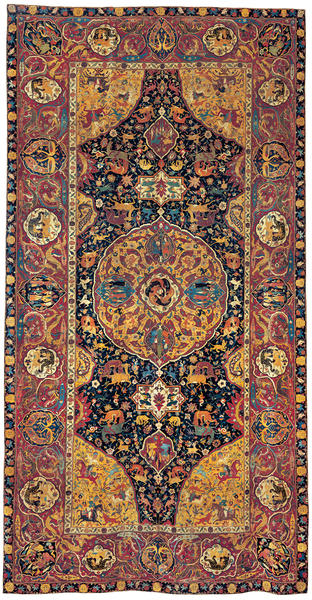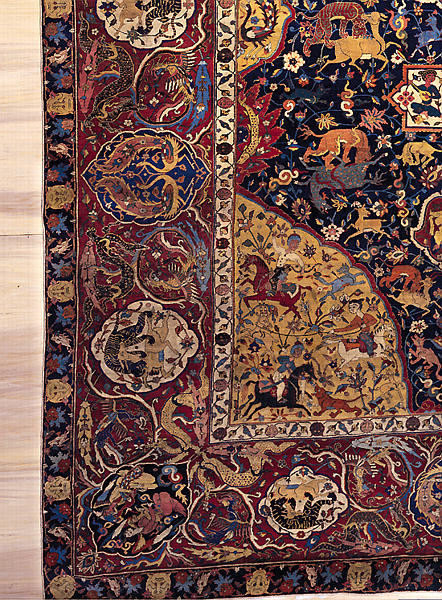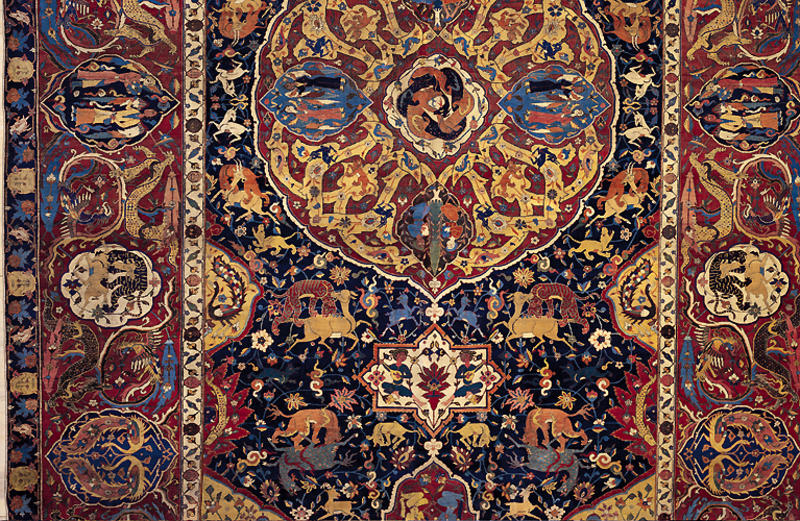Medallion and Animal Carpet
- Iran
- Safavi period
- 16-17c
- Wool pile on cotton, wool, and silk foundation
- H-594.3 W-320
Catalogue Entry
Persian carpets are among the best Islamic carpets. These include the two well-known Ardabil carpets, and the masterpieces among masterpieces-the family of Sanguszko carpets, of which this is the prototype and namesake.
It is not clear where this carpet went after it was woven in a royal workshop, but it was in the palace of the Ottoman emperor in Istanbul in 1621 when the Ottoman Turks were defeated by the Austrians at the Battle of Khotin, which included a flank attack by Prince Sanguszko of Poland. The carpet was taken to the Prince-General's tent as war booty, and remained in the possession of the Sanguszko family. It was first exhibited in 1904 at St. Petersburg. It was rediscovered by Arthur Upham Pope and shown again in 1931 in London, at the International Exhibition (Congress) of Persian Art, where it caused a great sensation. For the next twenty-three years, Pope had it on loan exhibition.
The carpet was displayed in 1949 for the visit of the Shah of Iran to Pope's Asia Institute in New York. In 1951 Pope saw a picture of the war vest of Toyotomi Hideyoshi (1536-1598) that is made from a Kashan flat weave, with the figure of a tiger attacking an antelope, and Pope recognized the design as coming from the same cartoon as that used for this carpet. When the Institute closed down in 1954, Pope advised Prince Roman Sanguszko to place the carpet on loan to The Metropolitan Museum of Art, where it was displayed until 1995, when it was sold. For four hundred years, the vicissitudes of history kept the Sanguszko carpet moving on a long pilgrimage from place to place, but at last it has found a safe and permanent home.
The name of the carpet comes from its former owner. A group of about fifteen carpets of a similar type woven in the sixteenth and seventeenth centuries, now in collections in the United States and Europe, have come to be known as Sanguszko carpets.
The majestic and elegant design of this carpet has a medallion in the central field, with two entwined dragons. Above and below it on the vertical axis are a pendant and cartouche. In each of the four corners, a quarter-circle is worked in. Overall, the composition is symmetrical, both lengthwise and crosswise.
Within each compartment, there are scenes of courtiers enjoying the hunt and music, angels of paradise (houris), and magnificent combat scenes of lions and sheep, deer and real-life birds and animals. There are peacock and fish, which have auspicious significance, as well as mythological imaginary animals from China such as dragons, phoenixes, and qilin. The various animals in combat fill the field and wide border, while a row of masks of animals adorn the outer border. Such fierce battles between legendary animals and birds would never occur in Chinese art, where dragons and phoenixes are symbols of the heavenly emperor and empress. Persian artisans, who loved using such motifs in combat, created their own designs according to their tradition. Arabesques are used in every space possible in the background. Many of the scenes in this carpet portray the paradise promised to believers in Islam.
The grandiose design, while filled with minutely drawn details, nevertheless contains vivid portraits. More than just a carpet design, it makes one think of a spectacular painting; there can be no doubt that a well-known painter participated in its creation.
It is thought that this carpet was made during the reign of Shah 'Abbas I (r. l588\-1629), the fifth shah of the Safavid dynasty, when arts and crafts were at their highest level.1 At that time, there was a great deal of cultural exchange with the East, which accounts for the arrival from China of the phoenix and dragon motifs. It is a felicitous happenstance that, as noted by Pope in 1951, this carpet has designs identical to those found on a battle vest said to have belonged to the warlord Hideyoshi, which has long been in the collection of the Kodaiji Temple in Kyoto. This gorgeous battle vest, made from a kilim woven in Iran, and the Sanguszko carpet, made at about the same time and perhaps in the same workshop at a time when Persian culture had reached its zenith, have met once again in modern-day Japan.
TS
1. Fully discussed in Pope l938\-39.


